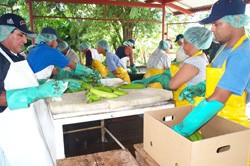
The southern state of Rivas is the traditional home for Nicaragua’s plantain fields, where more than 50,000 acres are under cultivation. But neglected fields produced small yields and undersized fruit. And in recent years, local prices have declined, making the U.S. market — with a sales potential of 12 million pounds a year worth $3 million — an attractive alternative that could increase local incomes and provide more jobs.
A USAID-funded program is working with 49 Rivas plantain producers to help them enter the U.S. market. The program, which has already generated 200 new jobs, helps farmers meet export standards through better crop management and processing. In addition, trained personnel ensure quality and sanitation control in a packing plant financed, constructed and supervised by the USAID program.
In May 2004, the first container of Nicaraguan plantains was shipped to Miami. Now more than 80,000 pounds of Nicaraguan plantains are exported weekly to the United States, destined for markets in Miami, Tampa, Chicago, Houston, New York, and Washington, DC. With the inauguration of a second processing and packing plant in November 2004, exports are expected to eventually climb to 160,000 pounds a week, creating 300 more jobs.







Comment
Make a general inquiry or suggest an improvement.